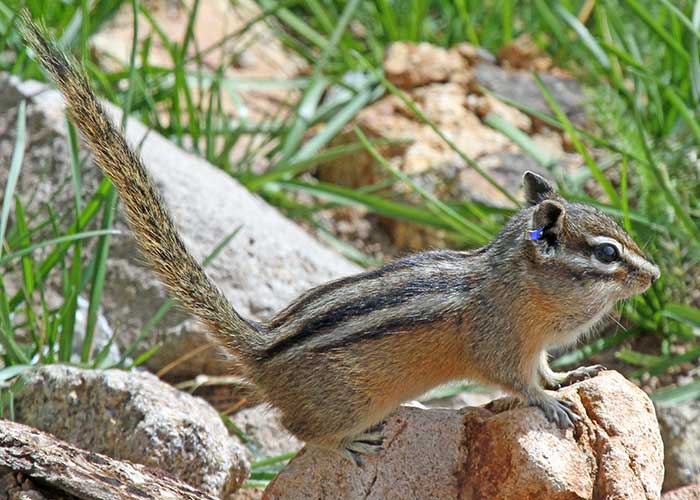Lawsuit demands federal action to save native New Mexico chipmunk from extinction
A lawsuit alleged federal inaction to protect a chipmunk native to the mountains of southern New Mexico after the species’ numbers dwindled and it was believed at risk of extinction.
The U.S. Fish and Wildlife Service in 2021 proposed listing the Penasco least chipmunk as an endangered species – the highest level of federal protection which would also require the setting aside of lands from development believed critical to the chipmunk’s survival – via a 12-month finding.
But in a lawsuit filed this week by the Center for Biological Diversity, the group argued the agency’s had since failed to finalize the listing and protect the species.
More:Checkerspot butterfly listed as endangered in New Mexico, despite rancher opposition
The suit included 14 other species the Center contended were illegally ignored by the Fish and Wildlife Service throughout the U.S., including several species of freshwater mussels in Texas and other southern states.
The finding was issued Sept. 28, 2021, in response to a petition the Center filed to the Service in October 2011, also proposing to set aside about 6,574 acres in New Mexico, the suit read.

The Penasco chipmunk is native to the Sacramento and White Mountains in south-central New Mexico around the Lincoln National Forest near Ruidoso and Alamogordo.
More:Lesser prairie chicken numbers dwindle as federal protections take effect this month
Camila Cossio, an attorney at the Center said that delaying federal listings for the chipmunk and other species included in the litigation could put them at greater risk of extinction and imperil the ecosystems they need to survive.
“Every day that protection is delayed, these species are at a greater risk of extinction,” Cossio said. “These species highlight the range of biodiversity imperiled by the extinction crisis, from a tiny chipmunk in New Mexico to six Texas freshwater mussels who are vital to the health of central Texas rivers.”
In its proposal to list the chipmunk, the Fish and Wildlife Service said it was especially threatened by recreational activities in the area – a popular tourism destination – along with wildfires, human development and encroachment on the forest.
More:New Mexico could play role in saving jaguars from extinction, petition says
About 54 percent of the chipmunk’s current range is within the Lincoln National Forest White Mountain Wilderness Area, already affording it some federal protections.
A recent shift in agricultural activities in the Sacramento Mountains portion of its range, from cultivation to pasture use and grazing, impacted the chipmunk’s food source, read the proposal.
The species is also threatened by invasive species like feral hogs, and by a lack connectivity between populations, resulting in low genetic diversity, the proposal read.
More:Restrictions on coyote killings in New Mexico could protect endangered lobos, petition says
Although the chipmunks historic range included both mountain ranges in in Lincoln and Otero counties, today the Fish and Wildlife Service reported it’s only known population is “isolated” within the White Mountains.
“It is suspected that the White Mountains and Sacramento Mountains populations may have been physically separated over a long time period with little to no genetic interchange, based on morphometric differences in collected specimens,” read the proposal.
“Redundancy has declined dramatically because the Peñasco least chipmunk remains on the landscape in only one population. As such, the Peñasco least chipmunk is at greater risk of extinction due to a catastrophic event when compared to historical conditions.”
More:Lawsuit to protect minnow imperiled in Pecos River, Rio Grande of southern New Mexico
The listing was opposed by New Mexico agricultural industry leaders, with the New Mexico Farm and Livestock Bureau (NMF&LB) arguing it could have devastating impacts on ranchers in the region, via submitted public comments.
The Bureau argued the federal government should instead encourage voluntary conservation measures with local landowners and avoid broad restrictions to the land.
“We oppose the listing of additional species as threatened or endangered under the Endangered Species Act as written,” read the comments.
“NMF&LB urges the U.S. Fish and Wildlife Service to instead explore options to work in collaboration with local affected stakeholders to employ voluntary conservation programs to ensure respect for private property rights and best uses of the land in their efforts.”
More:Lobo recovery plan challenged by New Mexico conservation groups in federal court
Reductions to access for grazing could also negatively affect the environment and local economy, the Bureau contended, as the process can help reduce fuel for wildfires while also supporting agricultural activities – a central industry in the area.
“Livestock grazing can be used as a tool to mitigate wildfires, a primary potential threat to the species, in addition to providing food for local communities and revenue for local economies,” the letter read.
“NMF&LB asks that actions taken by the U.S. Fish and Wildlife Service in response to this proposal do not jeopardize current or future use of grazing as a valuable tool in ensuring healthy forests.”
More:New Mexico needs $9 million to access wildlife restoration funds if bill passes Congress
The proposal to list the chipmunk was supported by the New Mexico Department of Game and Fish, as the species was listed as endangered by the State of New Mexico in 1983.
The Department said it would work closely with the federal agency to conserve the species, and collaborate with the New Mexico State University to continue studying its conditions and recovery.
“The Department is committed to continuing management and conservation of the Peñasco Least Chipmunk into the future,” read the Department’s comments. “The Department concurs with the major conclusions of the proposed rule, including the need for additional protection of the subspecies and its limited habitat.”
Adrian Hedden can be reached at 575-628-5516, achedden@currentargus.com or @AdrianHedden on Twitter.
This article originally appeared on Carlsbad Current-Argus: Lawsuit demands federal action to save native New Mexico chipmunk

